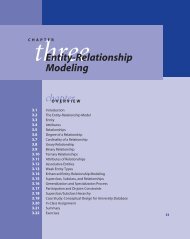Web-DSS-Chapter-03
Web-DSS-Chapter-03
Web-DSS-Chapter-03
You also want an ePaper? Increase the reach of your titles
YUMPU automatically turns print PDFs into web optimized ePapers that Google loves.
SECTION 3.22 ■ Exercises 71<br />
12. Using an example, define the following terms:<br />
subtype, subtype discriminator, disjoint rule,<br />
overlapping rule. Demonstrate how they relate to<br />
one another.<br />
13. Using an example, explain the reasons why a<br />
database designer considers using subtype/supertype<br />
relationships.<br />
14. The Admissions office in a university stores the<br />
information about the university entrance applications<br />
in a database. In order to facilitate processing<br />
the applications, the office classifies the<br />
applicants as freshman, transfer, graduate, and<br />
international students.<br />
a. Draw the EE-R diagram of this database. Identify<br />
a unique attribute for each entity subtype.<br />
b. Add a subtype discriminator for each of the<br />
subtypes of the entity APPLICANT.<br />
15. Using an example, explain the difference between<br />
the generalization rule and the specialization rule.<br />
16. The Accounting department in a company keeps<br />
the information about its employees in a database.<br />
The employees are classified as part-time<br />
employees, full-time employees, and interns.<br />
Interns are usually students who work with the<br />
company during the summers. Complete the<br />
EE-R diagram below by:<br />
a. Adding a unique attribute (relationship) for<br />
each entity subtype<br />
b. Adding an attribute shared by all entities<br />
c. Identifying whether the disjoint or overlap<br />
rule applies<br />
d. Identifying whether the total specialization or<br />
partial specialization rule applies<br />
3.22.2 Hands-On Exercises<br />
1. Savannah’s family has owned and operated a 640-<br />
acre farm for several generations. Since the business<br />
is growing, Savannah is considering building<br />
a database that would make it easier to manage<br />
the farm’s activities. She is considering the following<br />
requirements for the database:<br />
a. For each livestock classification group (for<br />
example: cow, horse, etc.), Savannah keeps<br />
track of each animal’s identification number<br />
and classification.<br />
b. For each crop, she records the crop identification<br />
number and the classification.<br />
c. Savannah has recorded the yield of each crop<br />
classification group during the last ten years.<br />
The records consist of the year, yield, sales,<br />
crop price, and amount of money earned.<br />
d. Savannah has also recorded the yield of each<br />
livestock classification group during the last<br />
ten years. The records consist of the following<br />
historical data: the year, the (historical) selling<br />
price per head, the number of livestock in the<br />
end of the year, the number of livestock sold<br />
during a one-year period, and the total<br />
amount of money earned.<br />
Draw an E-R diagram for this application. Specify<br />
the key attribute of each entity type.<br />
2. The Coca Cola Company in Atlanta, Georgia<br />
produces a wide range of products that are delivered<br />
to its worldwide clientele once a week. The<br />
company stores information about its employees,<br />
products, and customers in a database that includes<br />
the following set of tables:<br />
a. The company records the following information<br />
about its customers: customer identification<br />
number, name, address, X (longitude)<br />
and Y (latitude) coordinates of their location,<br />
and the amount of time (in fractions of an<br />
hour) required making a stop at that location.<br />
b. Each employee has an employee identification<br />
number, name, address (which consists of a<br />
city, state, and zip code), gender, birth date,<br />
position in the company, wage earned per<br />
hour of regular time work, wage earned per<br />
hour of overtime work, number of dependents,<br />
and number of years worked for the<br />
Coca Cola Company.<br />
c. Each product has a product identification<br />
number, price, and number of units produced<br />
per day.<br />
Products may be ordered by one or more customers,<br />
and a customer may order one or more<br />
products. Furthermore, employees produce one<br />
or more products, and a product may be produced<br />
by exactly one employee. Draw an E-R<br />
diagram for the above description and add the<br />
minimum and maximum relationship cardinalities.<br />
Identify the key attributes for each entity and<br />
the composite attributes.<br />
3. Consider the database in Hands-On Exercise 2.<br />
Update the E-R diagram for the cases described<br />
below. For each entity, identify the key<br />
attribute(s).



